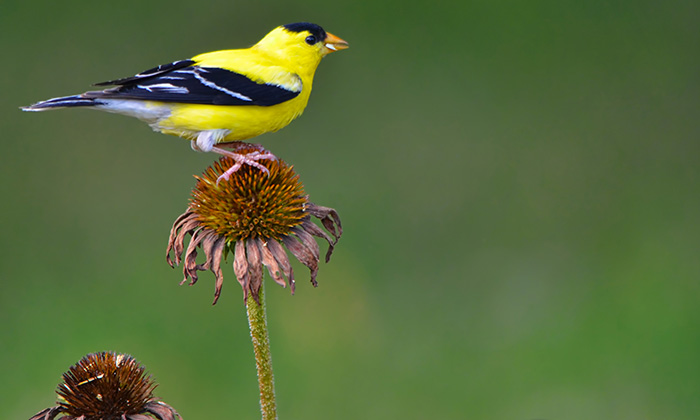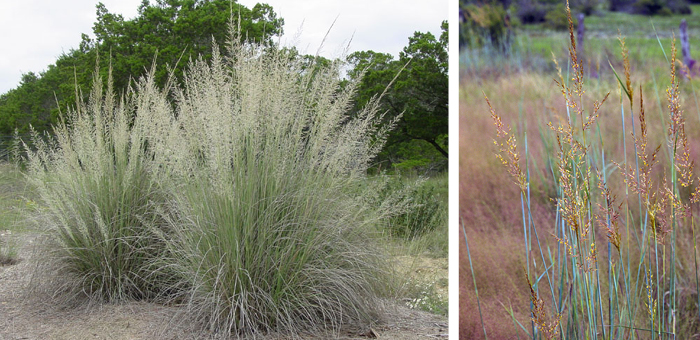Skip the Bird Feeder

A male American goldfinch feeding atop a coneflower in the genus Echinacea. Foraging wild birds benefit the most from access to native plants. PHOTO Chad Horwedel
“If you plant it, they will come,” is something of an unspoken mantra among Wildflower Center staff. The Center’s beautiful native landscapes not only attract Homo sapiens but draw wildlife that ranges from ring-tailed cats to roadrunners to a family of great horned owls that nests in the gardens each spring.
Homeowner landscapes can also offer havens to wildlife when containing native plants that birds and others visit for food, shelter and more. Most North American songbirds, for instance, depend on insects present on native plants to feed their young.
If a bird feeder seems like a quick cure-all, it turns out they’re more hovel than haven for our wild friends. A study published this summer of backyards in 25 Chicago suburbs found 36 species of birds visiting them. The more diverse the vegetation and the fewer the cats, the more bird species were counted. However, having a bird feeder didn’t increase the number or the variety of wild species cataloged.
A separate study published this past spring revealed that bird feeders at homes in New Zealand increased the populations of introduced species such as house sparrows. Meanwhile, the native grey warbler dwindled in numbers while the feeders were out. The way birds flock at feeders may have a downside, too, as an eye disease in house finches has recently been shown to spread more quickly among birds congregating at feeders.
With the winter ahead in mind, Horticulturist Sierra DaSilva offers the following seed-producing native plant suggestions to consider when creating a landscape with avian appeal.
Keep in mind that some flowering natives have seeds that will benefit titmice and other small birds, whereas others favor the big guys like grossbeaks that can crack harder seeds while perched on the ground or resting on larger branches. In general, DaSilva notes, it takes two to three weeks for seeds to ripen. Keeping “deadheads” of dried flowers on stalks for a month or two after seeds ripen adds structural beauty to your landscape while helping hungry wildlife.

Texas liatris (Liatris punctata) and prairie goldenrod (Solidago nemoralis) offer beauty and nutrients to garden wildlife. PHOTOS Joe Marcus and Ray Matthews, respectively
Herbaceous Options
Gayfeather species, including Texas liatris (Liatris punctata), provide plentiful small seeds: “It’s a really good late summer and fall bloomer that attracts goldfinches and titmice, among other birds,” DaSilva notes. She recommends leaving flower stalks standing about 1 ½ months before cutting liatris down in early winter.
Among goldenrod species, two that produce good amounts of seed come fall are tall goldenrod (Solidago altissima) and prairie goldenrod (Solidago nemoralis). Tall goldenrod reaches up to six feet, while the other rarely tops two feet, so you can choose whichever best fits your garden’s profile.
Frostweed (Verbesina virginica) gives your family novel wintertime fun and birds abundant seeds. It thrives in partial shade, such as on the edge of a woodland. When a hard freeze happens, the stems exude ribbons of ice. (Bonus: when in flower it’s a great butterfly attractor, too.)
Sages such as cedar sage and lyreleaf sage (Salvia lyrata) can serve as a ground cover when planted en masse, and can tolerate mowing. Lesser goldfinches are said to perch on the flower stalks to eat the seeds, although birds often ground forage for seeds of sages.
Many members of the sunflower family also offer plentiful high–fat seeds. Painted bunting, nuthatches, mockingbirds and others will favor big sunflowers such as the common sunflower (Helianthus annuus).You can also consider Engelmann’s daisy (Engelmannia peristenia) which sparrows, finches and others favor in the fall. Or if yellow isn’t your favorite shade, there’s purple coneflower (Echinacea purpurea), a perennial favorite for goldfinches, chickadees and other small birds.

Among the ornamental grass “bird feeders” is big muhly, whose seeds often are ripe throughout November. It occurs naturally in just one region of Texas, but Indian grass is native to most states. PHOTOS Sam C. Strickland, and Sally and Andy Wasowski, respectively
Grassroot Granaries
While it’s easy to think of adding flowering natives to a yard, ornamental and other grasses often get overlooked. They can add visual variety to a designed space, and seeds to fill bird bellies.
Big muhly (Muhlenbergia lindheimeri) is a large, beautiful ornamental grass with ripe seeds from September through November. This grass also provides good nesting or den material for wildlife. Or there’s blue grama (Bouteloua gracilis), an ornamental clumping grass that stays short and is very drought tolerant. “It has interesting seed heads that remind me of eyelashes,” DaSilva says. Like buffalograss (Bouteloua dactyloides), blue grama can also be mowed and used as a lawn option.
A grass she uses in her own yard, Indian grass (Sorghastrum nutans), is found in most states and makes good nesting material. It has ripe seeds October into December. “It’s absolutely gorgeous, a tall blueish grass with deep yellow-golden seed heads.”
And don’t forget to consider trees that produce seeds. For example, Texas redbud (Cercis canadensis), can serve as a showy understory tree that flowers even before its leaves emerge in early spring. Those flowers morph into late summer seeds that can last well into winter. “If you plan your space with birds in mind,” DaSilva says, “you can easily offer them something for every season.”
